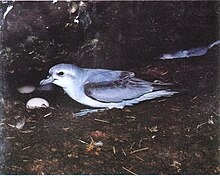 Louisa Island and Louisa Bay from the air Louisa Island and Louisa Bay from the air | |
 | |
| Geography | |
|---|---|
| Location | South West Tasmania |
| Coordinates | 43°32′02″S 146°21′32″E / 43.534°S 146.359°E / -43.534; 146.359 |
| Archipelago | Maatsuyker Islands Group |
| Adjacent to | Southern Ocean |
| Area | 23 ha (57 acres) |
| Highest elevation | 80 m (260 ft) |
| Administration | |
| Australia | |
| State | Tasmania |
| Region | South West |
| Demographics | |
| Population | Unpopulated |
Louisa Island is an island with a short sandy tombolo, located adjacent to the south-western coast of Tasmania, Australia. The irregularly shaped 23-hectare (0.089 sq mi) island is part of the Maatsuyker Islands Group, and comprises part of the Southwest National Park and the Tasmanian Wilderness World Heritage Site.
The island's highest point is 80 metres (260 ft) above sea level and, at low tide, the island is joined to the mainland by a 250 metres (820 ft) sand spit.
Flora and fauna

The central parts of the island are lightly forested with Eucalyptus nitida and Eucalyptus ovata, with an understorey of Leptospermum scoparium and Melaleuca squarrosa. Bracken covers areas subjected to recent fires.
The island is part of the Maatsuyker Island Group Important Bird Area, identified as such by BirdLife International because of its importance as a breeding site for seabirds. Recorded breeding seabird and wader species are the little penguin, short-tailed shearwater (206,000 pairs), fairy prion (400 pairs), common diving-petrel (1600 pairs), Pacific gull, sooty oystercatcher and pied oystercatcher. Mammals present include the Tasmanian pademelon and long-nosed potoroo. The Tasmanian tree skink is present.
See also
References
- ^ "Small Southern Islands Conservation Management Statement 2002" (PDF). Tasmania Parks and Wildlife Service. 2002. Archived from the original (PDF) on 22 August 2006. Retrieved 20 July 2006.
- ^ Brothers, Nigel; Pemberton, David; Pryor, Helen; & Halley, Vanessa. (2001). Tasmania’s Offshore Islands: seabirds and other natural features. Tasmanian Museum and Art Gallery: Hobart. ISBN 0-7246-4816-X
- "Important Bird Area factsheet: Maatsuyker Island Group". Archived from the original on 23 May 2023. Retrieved 23 May 2023.
| South West region of Tasmania, Australia | |||||||||||||
|---|---|---|---|---|---|---|---|---|---|---|---|---|---|
| Settlements | |||||||||||||
| Governance | |||||||||||||
| Mountains |
| ||||||||||||
| Protected areas, parks and reserves |
| ||||||||||||
| Rivers | |||||||||||||
| Lakes | |||||||||||||
| Lake Pedder controversy | |||||||||||||
| Dams Franklin controversy | |||||||||||||
| Harbours, bays, inlets and estuaries | |||||||||||||
| Coastal features | |||||||||||||
| Power stations | |||||||||||||
| Transport |
| ||||||||||||
| Landmarks |
| ||||||||||||
| People of note | |||||||||||||
| Islands |
| ||||||||||||
| Books and newspapers | |||||||||||||
| Flora, fauna, and fishlife | |||||||||||||
| Bioregions | |||||||||||||
| Indigenous heritage | |||||||||||||
This Tasmania geography article is a stub. You can help Misplaced Pages by expanding it. |